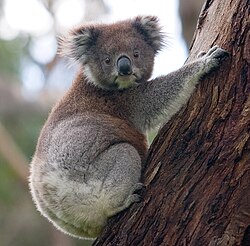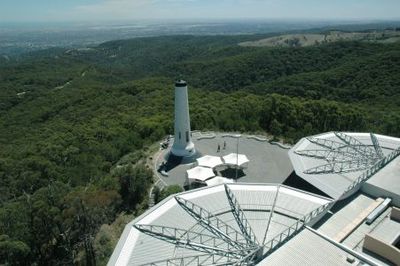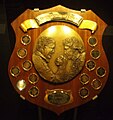Portal:Australia
| Showcase | Content | Interesting facts | Contributing |
Introduction

Australia, officially the Commonwealth of Australia, is a country comprising the mainland of the Australian continent, the island of Tasmania and numerous smaller islands. It has a total area of 7,688,287 km2 (2,968,464 sq mi), making it the sixth-largest country in the world and the largest in Oceania. Australia is the world's flattest and driest inhabited continent. It is a megadiverse country, and its size gives it a wide variety of landscapes and climates including deserts in the interior and tropical rainforests along the coast.
The ancestors of Aboriginal Australians began arriving from south-east Asia 50,000 to 65,000 years ago, during the last glacial period. By the time of British settlement, Aboriginal Australians spoke 250 distinct languages and had one of the oldest living cultures in the world. Australia's written history commenced with Dutch exploration of most of the coastline in the 17th century. British colonisation began in 1788 with the establishment of the penal colony of New South Wales. By the mid-19th century, most of the continent had been explored by European settlers and five additional self-governing British colonies were established, each gaining responsible government by 1890. The colonies federated in 1901, forming the Commonwealth of Australia. This continued a process of increasing autonomy from the United Kingdom, highlighted by the Statute of Westminster Adoption Act 1942, and culminating in the Australia Acts of 1986.
Australia is a federal parliamentary democracy and constitutional monarchy comprising six states and ten territories. Its population of almost 28 million is highly urbanised and heavily concentrated on the eastern seaboard. Canberra is the nation's capital, while its most populous cities are Sydney and Melbourne, both with a population of more than 5 million. Australia's culture is diverse, and the country has one of the highest foreign-born populations in the world. It has a highly developed economy and one of the highest per capita incomes globally. Its abundant natural resources and well-developed international trade relations are crucial to the country's economy. It ranks highly for quality of life, health, education, economic freedom, civil liberties and political rights.
Featured article -

The koala (Phascolarctos cinereus), sometimes inaccurately called the koala bear, is an arboreal herbivorous marsupial native to Australia. It is the only extant representative of the family Phascolarctidae. Its closest living relatives are the wombats. The koala is found in coastal areas of the island's eastern and southern regions, inhabiting Queensland, New South Wales, Victoria, and South Australia. It is easily recognisable by its stout, tailless body and large head with round, fluffy ears and large, dark nose. The koala has a body length of 60–85 cm (24–33 in) and weighs 4–15 kg (8.8–33.1 lb). Its fur colour ranges from silver grey to chocolate brown. Koalas from the northern populations are typically smaller and lighter in colour than their counterparts further south. These populations are possibly separate subspecies, but not all researchers accept this. (Full article...)
Selected biography -
Hilda Rix Nicholas (née Rix, later Wright, 1 September 1884 – 3 August 1961) was an Australian artist. Born in the Victorian city of Ballarat, she studied under a leading Australian Impressionist, Frederick McCubbin, at the National Gallery of Victoria Art School from 1902 to 1905 and was an early member of the Melbourne Society of Women Painters and Sculptors. Following the death of her father in 1907, Rix, her only sibling Elsie and her mother travelled to Europe where she undertook further study, first in London and then Paris. Her teachers during the period included John Hassall, Richard Emil Miller and Théophile Steinlen. (Full article...)
Did you know (auto-generated) -
- ... that Edward Thonen, one of the miners killed in the Eureka Rebellion, had gained notoriety in England as a jewellery thief prior to his emigration to Australia?
- ... that "The Potato King of Colorado" survived a shipwreck, mined for gold in Australia, and helped establish an alcohol-free Methodist colony?
- ... that Australia's most threatened butterfly is confined to a native range of less than 10 square kilometres (3.9 sq mi)?
- ... that when Australian Brihony Dawson debuted as the first non-binary host of reality TV franchise The Challenge, they decided not to imitate the "ominous" style of the U.S. host?
- ... that the South Australian Labor politician Ernest Roberts served two tours in South Africa during the Second Boer War?
- ... that the dominant species in the Iron-grass Natural Temperate Grassland of South Australia are often not grasses at all?
- ... that the United Ukrainian Ballet Company, consisting of exiled dancers based in The Hague, has toured the UK, Singapore, Australia and the US?
- ... that Peter Read coined the term "Stolen Generations" to refer to Aboriginal children who were forcibly separated from their families by Australian governments?
In the news
- 8 March 2025 – 2024–25 Australian region cyclone season
- Cyclone Alfred
- One person is confirmed killed and thirteen others are injured in floods caused by Cyclone Alfred as it passes through Queensland and New South Wales, Australia. (AP)
- 5 March 2025 – 2024–25 Australian region cyclone season
- Tropical Cyclone Alfred
- Queensland Premier David Crisafulli announces the suspension of public transport services and the closure of 640 schools in South East Queensland, Australia, as Cyclone Alfred is expected to make landfall early Friday morning local time. (ABC News Australia)
- 3 March 2025 – 2024–25 Australian region cyclone season
- Cyclone warnings are issued to residents of Brisbane, South East Queensland and the Northern Rivers region of New South Wales as Tropical Cyclone Alfred is expected to make landfall on Thursday or early Friday local time. (The Guardian Australia)
- 25 February 2025 – 2025 Queensland floods
- At least twelve people are killed by a melioidosis outbreak caused by standing waters from persistent flooding in Queensland, Australia. (7News)
Selected pictures -
On this day

- 1837 – The Hoddle Grid of streets for Melbourne's central business district is surveyed by Robert Hoddle.
- 1885 – HMQS Gayundah arrives in Brisbane. The Captain refuses to relinquish his command and is removed by a boarding party of Queensland Police.
- 1942 – The first shipload of 8398 American servicemen arrive in Sydney for action in the Pacific theater.
General images
Topics
More portals
WikiProject
 |
 |

| |
Consider joining WikiProject Australia, a WikiProject dedicated to improving Wikipedia's coverage of topics related to Australia. The project page and its subpages contain suggestions on formatting and style of articles, which can be discussed at the project's notice board. To participate, simply add your name to the project members page.
As of 28 March 2025, there are 207,665 articles within the scope of WikiProject Australia, of which 598 are featured and 893 are good articles. This makes up 2.98% of the articles on Wikipedia, 5.28% of all featured articles and lists, and 2.16% of all good articles (see WP:AUSFG). Including non-article pages, such as talk pages, redirects, categories, etc., there are 415,330 pages in the project.
Associated Wikimedia
The following Wikimedia Foundation sister projects provide more on this subject:
-
Commons
Free media repository -
Wikibooks
Free textbooks and manuals -
Wikidata
Free knowledge base -
Wikinews
Free-content news -
Wikiquote
Collection of quotations -
Wikisource
Free-content library -
Wikiversity
Free learning tools -
Wikivoyage
Free travel guide -
Wiktionary
Dictionary and thesaurus









































































































